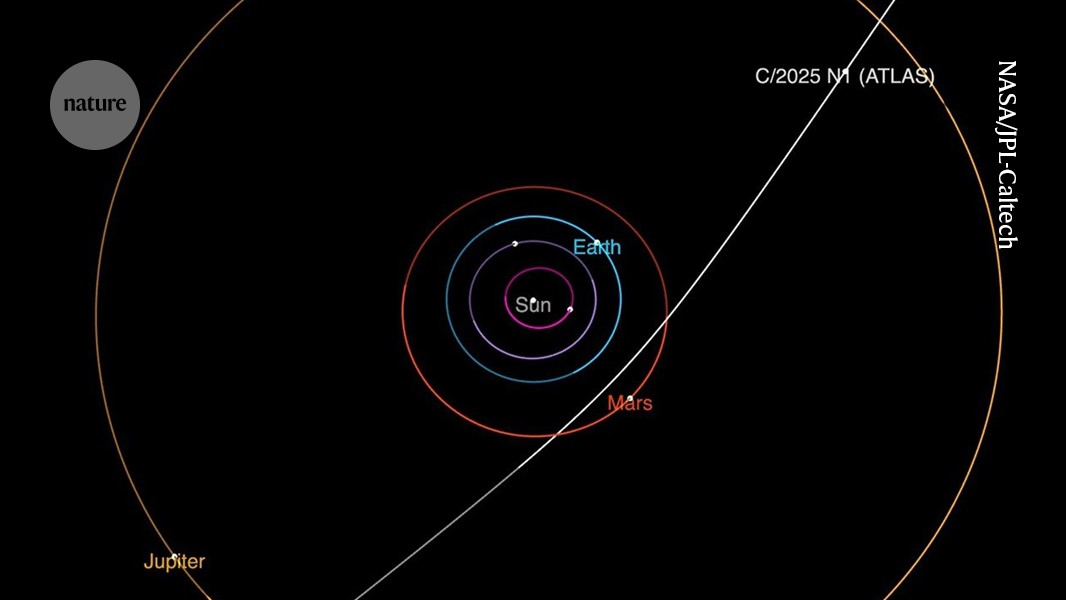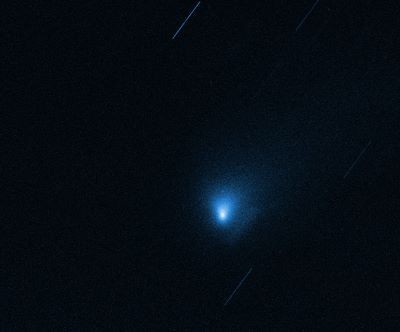
Only the third known interstellar object to enter our Solar System will swing so close to Mars that it might be visible to the Mars Reconnaissance Orbiter.Credit: NASA/JPL-Caltech
An object from another solar system is hurtling our way. It is just the third interstellar object ever spotted, though many others have likely gone by un-noticed.
The object gained an official name, C/2025 N1 or 3I/ATLAS, on Wednesday. Moving at a record-setting speed for an interstellar visitor, it is travelling along a curve but not in a closed loop – confirmation of its origins outside the Solar System. It will zoom past our Sun without being captured by its gravity.
The vast majority of comets and asteroids detected within our own Solar System also originated there. Only two other objects — ‘Oumuamua (1I), spotted in 2017, and Comet 2I/Borisov, seen in 2019 — have been acknowledged as interstellar in origin, meaning they travelled to our Solar System from another. The new object, 3I/ATLAS, is going far faster than those two and might be much older.
“This is fabulous,” says astronomer Michele Bannister at the University of Canterbury in New Zealand. “Working on 1I and 2I were transformational opportunities,” she says, and she expects 3I to be the same.
3I/ATLAS is currently just inside Jupiter’s orbit and is heading towards our Sun. It is expected to zoom through the inner solar system in October, at a speed of about 68 kilometres per second. A few researchers have seen a tail, hinting that it is venting gas and dust like a comet, rather than behaving like a rocky asteroid, according to the International Astronomical Union’s Minor Planet Center.
Caught on camera
The object was first spotted on 1 July by a telescope in Chile that is part of the Asteroid Terrestrial-impact Last Alert System (ATLAS), a NASA-funded project based at the University of Hawaii in Honolulu. This system automatically flags potentially interesting objects in the sky for human review. On average, the team reports about one object a day to the Minor Planet Center for follow-up by other astronomers. When ATLAS co-manager Larry Denneau, an astronomer at the University of Hawaii, clicked the button to submit this particular result, he says “it looked completely garden variety”.
How two intruders from interstellar space are upending astronomy
But other astronomers quickly discovered how special it is. They combed through new and archived data from a range of instruments to find more images of the same speck, including some from days or weeks beforehand. These were used to calculate the object’s trajectory, which revealed that 3I/ATLAS is on a very wide, open hyperbolic path, rather than orbiting our Sun in a closed ellipse, confirming that it is an interstellar object not tied to the gravity of any star.
“At that point it really hits you, that this little button push you did the night before has created this frenzy, and you have hundreds of astronomers and millions of interested people paying attention to it,” says Denneau.
Closer look
Researchers worldwide will now be turning their telescopes to 3I/ATLAS. It will be visible to observatories on Earth and in space long enough to get information on its composition, size, shape, and how it changes as it is heated by the Sun, all of which “will tell us about what conditions were like in the protoplanetary disk where it formed”, says Bannister.



